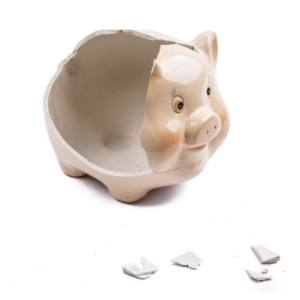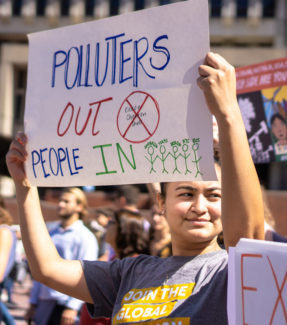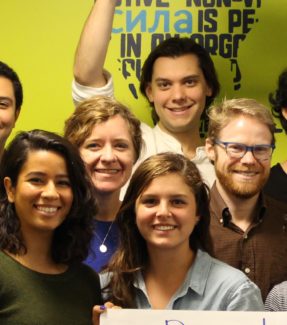Hurricane Maria hit the island of Puerto Rico on September 20, 2017. By October 15, nearly a month later, most Puerto Ricans still didn’t have electricity. That October morning, Felipe Figueroa Rosa woke up unable to breathe without his electric sleep apnea machine. Though his daughter called three times, an ambulance never came. Felipe’s death was one of at least 2,975 caused by Hurricane Maria and her aftermath, a death toll on par with the terrorist attacks of September 11, 2001.
The impact of Hurricane Maria could have been much less damaging if Puerto Rican officials were able to invest in infrastructure and resilience measures to protect their people. Instead, their hands were tied by a rapid expansion of public debt after 2006 tax changes left public agencies turning to predatory banks to make up enormous budget shortfalls. Servicing the debt built by Goldman Sachs, among other predatory banks, starved Puerto Rico’s public sector and services. Electricity infrastructure was left to crumble, hundreds of schools were shut down, and public officials were laid off en masse — all to make payments on debt structured to extract maximum profit for Goldman Sachs. When Maria struck a little over a decade later, Puerto Ricans thus had no resilient public core of infrastructure and services upon which to rely, leaving them to suffer and die.
Puerto Rico’s story, though especially horrifying, follows a devastating pattern by which predatory banks use debt to extract wealth from people’s lives and the public sector that supports them. In 2008, this pattern was common across the United States as almost one million families lost their homes to foreclosure in the unfolding of the subprime mortgage crisis. When their aggressive loans began to show predictable signs of distress, the banks were able to justify widespread foreclosures, stripping millions of families — disproportionately Black families — of wealth, credit and their very homes.
A year later, in 2009, suicide deaths surpassed motor vehicle deaths for the first time in history, a massive uptick researchers have linked in part to the wave of foreclosures. Ten years later, though top-line economic figures are ostensibly improved, economic inequality is at dizzying new heights. While the expansion of transnational corporate power and influence is to blame, most worthy of shame is a chief architect of this unequal economy — underwriter of transnational corporate greed: Goldman Sachs. The bank played a key role in both inflating the subprime mortgage bubble and deflating it, making billions in profit on both sides. It also continues to cultivate friends in high places, using its far-reaching influence to strip away profit-hindering regulations and deliver tax cuts to its billionaire board members and investors. Now, Goldman Sachs is wrapping its tentacles ever tighter around Puerto Rico, leveraging exploitative debt to extract all the wealth it can.
What Goldman Sachs did to earn your vote
Puerto Rico has been a colony of the United States since 1898 when the United States invaded the island, wresting it from Spain during the Spanish-American war. Over the course of the first three decades, absentee corporations developed the island into a brutally profitable sugar plantation while the U.S. military occupied the island as a base for protecting its interests in the region. Nothing has substantially altered Puerto Rico’s legal status during the intervening decades. However, the globalizing economy — spurred by U.S.-led free trade agreements like CAFTA-DR — hollowed out Puerto Rico’s industrial economic core. This, in addition to the expiration in 2006 of a federal tax break for corporate income, forced the Puerto Rican government into substantial deficits further worsened by the 2008 financial crisis. Smelling profit, Goldman Sachs and other predatory Wall Street banks stepped in to underwrite deals that could infuse cash into the island’s government.
Since 2006, Puerto Rico and its public agencies sold tens of billions of dollars in bonds over the course of almost 90 different deals. In the process, Wall Street entities, including Goldman Sachs, collected over $750 million in underwriting fees. These deals have loaded Puerto Rico with debt, three times as much as the highest state’s debt load despite it being poorer than any U.S. state. While the magnitude of Puerto Rico’s debt is egregious equally so are its terms as underwritten by Wall Street. A huge chunk of the debt is held in capital appreciation bonds (CABs), the municipal version of payday loans. Unlike most loans which pay interest regularly, CABs compound all the interest into the principal balance, accruing interest upon interest over the life of the bond. This results in huge payouts for lenders, and extremely high effective interest rates for the public. Goldman Sachs underwrote just a few billion in CABs for Puerto Rico. Now, the outstanding balance is over $20 billion. In effect, Goldman Sachs is charging Puerto Rico an interest rate of over 700 percent, extortionary by any measure.
Goldman Sachs doesn’t limit its abusive financial scams to Puerto Rico. In early 2004, Goldman Sachs moved into the subprime mortgage market. It lent cash to unscrupulous firms to scale up business, then bought the junk they created and bundled it into securities to invest in. From 2005 to 2006, the bank underwrote close to a $250 billion in junk securities. But by the end of 2006, it became evident that many subprime mortgage holders were likely going to default or declare bankruptcy, requiring an adept maneuver to ensure Goldman Sachs wouldn’t be left holding the bag. In a maneuver famously portrayed in the movie “The Big Short,” it shorted the market by off-loading the soon-to-be-worthless securities while laying down bets that the market would fail. A hedge fund manager following Goldman’s actions in this period called this tactic “the heart of securities fraud.” The bank concealed from buyers the worthlessness of their purchases despite obvious knowledge to the contrary. As hundreds of thousands of families lost everything, Goldman Sachs made most of its money back in this way. What it fell short on, it recouped with about $22.9 billion of taxpayer bailout money.
Despite the obvious inhumanity of Puerto Rico’s situation and blatant unethical behavior of the 2008 financial crisis, Goldman Sachs retains significant influence at the highest levels of government that it actively deploys to block any challenge to its corrupt and deadly practices. In keeping with long-standing bipartisan tradition, President Trump employed, at one point, six Goldman Sachs alumni (including Secretary of Treasury Steven Mnuchin and former Chief Strategist Steve Bannon) in his administration. One notable alumnus, former Goldman Sachs Chief Operating Officer Gary Cohn, directed the National Economic Council and played a key role in passing Trump’s tax scam that slashed corporate tax rates from 35 percent to 21 percent. Cohn, an expert in public pillaging, was also the driving force behind the infrastructure plan floated by Trump that would have incentivized the widespread privatization of public infrastructure, including water systems, and allowed banks like Goldman Sachs to invest in and profit from newly-privatized infrastructure.
In regard to its work in Puerto Rico, federal rules would allow the Securities and Exchange Commission (SEC) to bring a disgorgement action against the bank for the predatory deals it made on the island (effectively clawing back its plundered loot). But it has yet to do so. Could it be that a fox — Jay Clayton, Chairman of the SEC and former Goldman Sachs executive — is guarding the henhouse?
Goldman’s ability to affect policy outcomes relevant to its business is not new, either: after Goldman Sachs CEO Lloyd Blankfein held two dozen meetings with Treasury Secretary and former Goldman Sachs CEO Hank Paulson in a single week, the Treasury Department announced a multi-billion dollar bailout to enable AIG (a major Goldman Sachs insurer) to pay its creditors in full. The payout for Goldman Sachs measured in the billions at a time when weakened corporations throughout the economy were paying most creditors a fraction of what they had borrowed.
A vote to shame Goldman Sachs is a vote for an economy that works for everyone
A decade ago, Goldman Sachs took taxpayers’ money to replenish the losses it incurred from an economic crash it was instrumental in provoking. And for more than a decade, it has used extremely strict loan terms to tie the hands of Puerto Rico’s officials, compromising their ability to protect the lives and essential services of the island’s residents. This year, hold Goldman Sachs accountable for its deadly tactics.
Tell Goldman Sachs that our economy is not their piggy bank and public services are not a tool to generate profits by taking these two actions: First, sign and share the People’s Demands for a just response to the climate crisis, a crisis underwritten by Wall Street banks like Goldman Sachs and which intensifies storms like Hurricane Maria. And second, vote for Goldman Sachs in our Corporate Hall of Shame to call it out for its deadly tactics.




